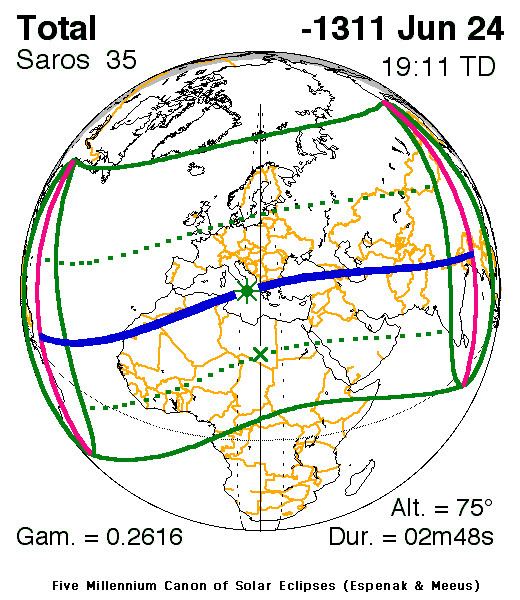 | ||
The solar eclipse mentioned in a text dating to the reign of Mursili II could be of great importance for the absolute chronology of the Hittite Empire within the chronology of the Ancient Near East. The text records an "omen of the sun," linked to the tenth year of Mursili's reign, which appeared just as he was about to launch a campaign against the Kingdom of Azzi-Hayasa in north-eastern Anatolia. According to the current debate, there are two possible candidates for the eclipse: 13 April 1308 BC or 24 June 1312 BC. The 1312 BC date is accepted by most Hittitologists, e.g. Trevor Bryce (1998), while Paul Åström (1993) has suggested the 1308 BC date. The two eclipse had different saros series, the first was saros 32 and the last was saros 37.
Contents
1312 eclipse
The 1312 eclipse (as occurred over northern Anatolia in the early afternoon, and its effects would have been quite spectacular for Mursili and his men on campaign:
24 June 1312 BC, total eclipse, maximum at 10:44 UTC, 38.2°N 13.7°E / 38.2; 13.7 (Sicily) and lasted 2 min 48 sec, some stated as it occurred inside the Ionian Sea at 17 E.Areas that were inside the maximum eclipse included the islands that are now Barlavento in Cape Verde, the Moorish lands (compromising modern day Mauritania, Western Sahara, Morocco and Algeria), Tunisia (then inner Africa), Greece, the Caucasus region, Persia (now Iran), in the area of the present-day Iranian-Turkmeni border, present-day Afghanistan and Pakistan and a part of the north of India.
The eclipse started off modern day Brazil in South America and finished in what is now Myanmar (sometimes as Burma)
1308 eclipse
In contrast, the 1308 eclipse was annular, and began very early in the morning over Arabia (and only penumbral over Anatolia and Syria), reaching its height over Central Asia:
13 April 1308 BC, annular eclipse (94.8%), maximum at 04:16 UTC, 44.9°N 85.7°E / 44.9; 85.7 (Tian Shan) and lasted 4 min 40 sec.Other areas that had inside the band of the annular eclipse included the Indus Delta and parts of Siberia including the New Siberian Islands. The maximum eclipse ended at sunset over the Beaufort Sea along with the Bering Sea and the westernmost portion of Alaska with the west of the Aleutian Islands. The eclipse covered much of Asia except for the southwesternmost portions and the southeastern islands, one of the island that was near the edge of the eclipse was Honshū, Japan.
Best suited date of the eclipse
Therefore, the 1312 eclipse would seem to best suit the eclipse mentioned. This means that Mursili would have begun his reign in either 1322 or 1321 BC. This date would be roughly that usually proposed for the death of Tutankhamun. It is known that Suppiluliuma I was besieging Carchemish when he received a letter from the widow of a Pharaoh (who is called Dakhamunzu in the annals). Suppiluliuma died shortly thereafter and his successor was Mursili II (whose brother would have been Prince Zannanza sent to Egypt where he died). Thus this appears to be a chronological anchor. However, there are other views, asserting for example that the dead Pharaoh was Akhenaten or that Tutankhamun died later.
